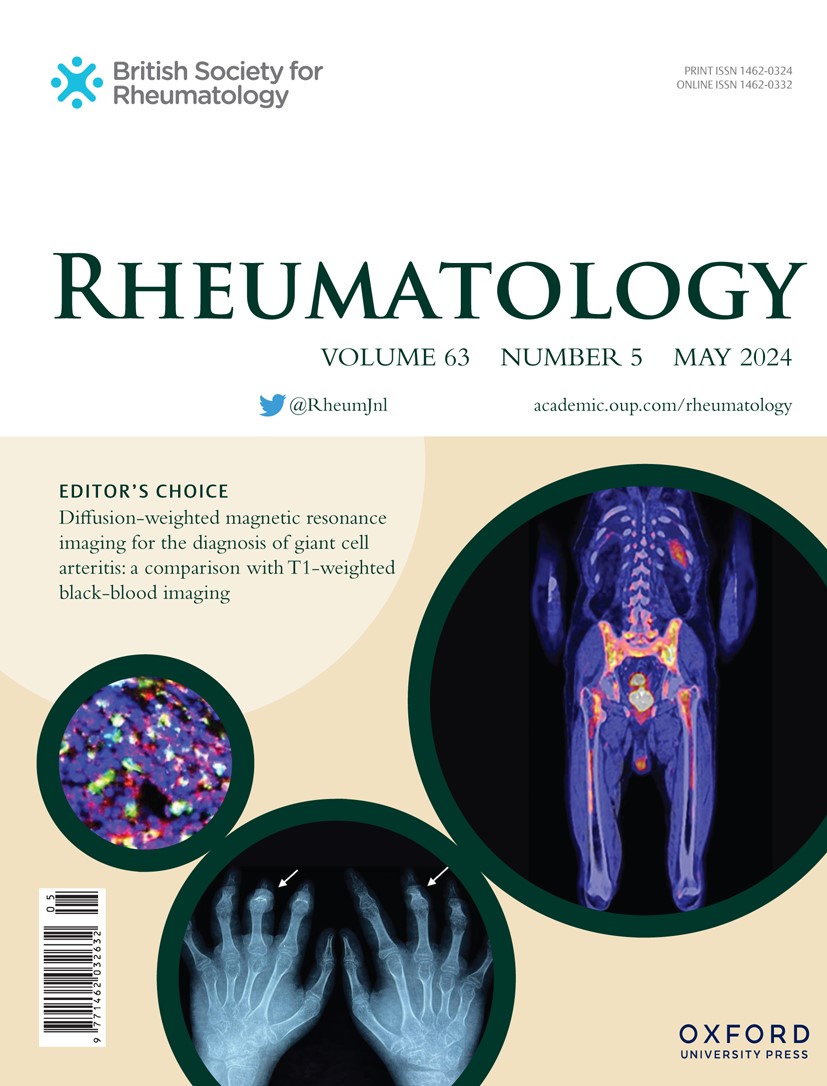Association between steatotic liver disease and risk of incident systemic sclerosis: a nationwide cohort study
IF 4.7
2区 医学
Q1 RHEUMATOLOGY
引用次数: 0
Abstract
Objective Antinuclear antibody (ANA) positivity has been observed in patients with steatotic liver disease (SLD); however, the link between SLD and ANA-positive connective tissue diseases remains unexplored. We aimed to evaluate the association between SLD and risk of systemic sclerosis (SSc), a representative ANA-positive connective tissue disease. Methods A longitudinal population-based cohort study using a Korean nationwide database was conducted. The analysis included 4,413 719 individuals who participated in a national health screening program in 2012, with a mean follow-up period of 9.21 ± 1.05 years. Participants were categorized based on SLD status into four groups: no SLD, metabolic dysfunction-associated liver disease (MASLD), metabolic dysfunction and alcohol-related liver disease (MetALD), and alcohol-related liver disease (ALD). The main outcome measure was incident SSc. Multivariable Cox proportional hazard models were used to evaluate the association between SLD and risk of incident SSc. Results Among the 4,413 719 individuals, 2,827 907 (64.07%) had no SLD, 1,344 494 (30.46%) had MASLD, 165 475 (3.75%) had MetALD, and 75 843 (1.72%) had ALD. Compared with individuals without SLD, those with MASLD (adjusted hazard ratio [HR]: 1.612 [1.276, 2.038]), MetALD (adjusted HR: 1.575 [0.816, 3.040]), and ALD (adjusted HR: 3.063 [1.635, 5.739]) had a higher risk of incident SSc, with MASLD and ALD reaching statistical significance. The risk was the highest among individuals with ALD. Conclusion SLD was linked to an increased risk of incident SSc. These findings underscore the need for effective monitoring and management of SLD, particularly by reducing excessive alcohol consumption, to lower the risk of incident SSc.脂肪变性肝病与系统性硬化症发生风险之间的关系:一项全国性队列研究
目的观察脂肪变性肝病(SLD)患者抗核抗体(ANA)阳性;然而,SLD与ana阳性结缔组织疾病之间的联系仍未被探索。我们的目的是评估SLD与系统性硬化症(SSc)风险之间的关系,系统性硬化症是一种代表性的ana阳性结缔组织疾病。方法采用韩国全国数据库进行纵向人群队列研究。该分析包括2012年参加国家健康筛查计划的4,413,719人,平均随访时间为9.21±1.05年。参与者根据SLD状态分为四组:无SLD、代谢功能障碍相关肝病(MASLD)、代谢功能障碍和酒精相关肝病(MetALD)和酒精相关肝病(ALD)。主要结局指标为SSc事件。采用多变量Cox比例风险模型评估SLD与SSc事件风险之间的关系。结果4413719例患者中,无SLD患者2827907例(64.07%),MASLD患者134494例(30.46%),MetALD患者165 475例(3.75%),ALD患者75 843例(1.72%)。MASLD组(校正风险比[HR]: 1.612[1.276, 2.038])、MetALD组(校正风险比:1.575[0.816,3.040])、ALD组(校正风险比:3.063[1.635,5.739])发生SSc的风险高于无SLD组,MASLD和ALD组发生SSc的风险均有统计学意义。ALD患者的风险最高。结论:SLD与SSc发生风险增加有关。这些发现强调了有效监测和管理SLD的必要性,特别是通过减少过度饮酒来降低SSc事件的风险。
本文章由计算机程序翻译,如有差异,请以英文原文为准。
求助全文
约1分钟内获得全文
求助全文
来源期刊

Rheumatology
医学-风湿病学
CiteScore
9.40
自引率
7.30%
发文量
1091
审稿时长
2 months
期刊介绍:
Rheumatology strives to support research and discovery by publishing the highest quality original scientific papers with a focus on basic, clinical and translational research. The journal’s subject areas cover a wide range of paediatric and adult rheumatological conditions from an international perspective. It is an official journal of the British Society for Rheumatology, published by Oxford University Press.
Rheumatology publishes original articles, reviews, editorials, guidelines, concise reports, meta-analyses, original case reports, clinical vignettes, letters and matters arising from published material. The journal takes pride in serving the global rheumatology community, with a focus on high societal impact in the form of podcasts, videos and extended social media presence, and utilizing metrics such as Altmetric. Keep up to date by following the journal on Twitter @RheumJnl.
 求助内容:
求助内容: 应助结果提醒方式:
应助结果提醒方式:


